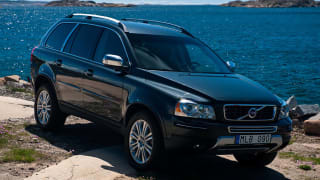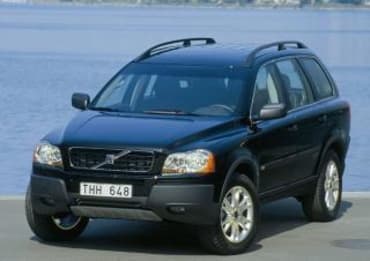
What's on this page
Volvo XC90 2003
This is what Ewan Kennedy liked most about this particular version of the Volvo XC90: Large and comfortable on the inside, Very practical seat layout, Packed with safety tech
The 2003 Volvo XC90 carries a braked towing capacity of up to 2250 Kg, but check to ensure this applies to the configuration you're considering.
Volvo XC90 News

Popular seven-seat SUV updated! 2025 Volvo XC90 revealed with tweaked design, new tech to stay fresh against Mazda CX-90, Lexus RX and BMW X5

Forget Tesla! Why Volvo is the car brand with the most to gain from rising electric car sales
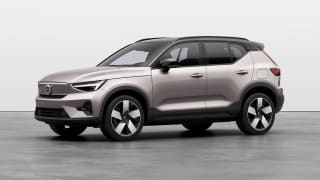
Tesla who? Volvo Australia's electric car play not affecting popularity as brand targets new sales record

Best electric cars arriving in 2023

Volvo vindication! Swedish brand confirms it is well over 50 per cent electrified in Australia as it plans to go electric-only by 2026
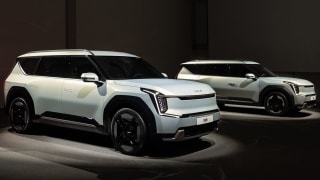
Best EV for towing? 2024 Kia EV9 electric car's surprising facts revealed, including the extended range, clever packaging and other innovations
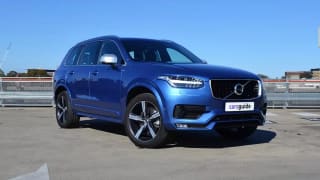
Getting exxy, XC? Volvo prices bumped up across the SUV range for 2023 as it hunts Genesis, Lexus, BMW and more
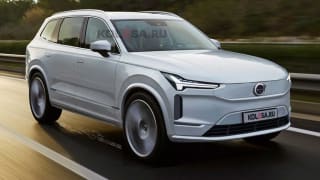
Volvo has teased more of its incoming EX90 electric SUV, so here's the story so far

Volvo is keeping an eye on electric car newcomers like BYD as it pushes down EV path
Volvo XC90 2003 Price and Specs
Volvo XC90 2003 Q&As
Check out real-world situations relating to the Volvo XC90 here, particularly what our experts have to say about them.
-
Turbocharger in 2006 Volvo XC-90 smoking despite being replaced
The first thing to figure out is what type of smoke it is; oil smoke or fuel smoke. If the smoke is black, then it’s probably excess fuel that is being injected into the engine. If the smoke is a bluish-grey, then it’s likely to be oil smoke. The major causes of oil smoke are worn piston rings or valve guides and their seals. If it’s either of those thing, it will be a fairly major repair bill.
But it would also be worth checking the crankcase ventilation system as this can cause an engine to smoke, too, and is a much simpler fix.
Show more -
Which popular mid to large SUV is best for a family?
This is a really interesting question, because most car-makers tend to quote their products’ luggage capacity in litres, rather than a set of dimensions in each direction. Even then, it’s not that simple as there are different methods fort calculating the cubic capacity of a load space, and the two methods are not readily comparable. It’s also a bit of a con-job, because a figure in litres mean very little to most people, while actual measurements in centimetres would be much more relatable.
In any case, since you obviously have two kids with cellos and school-bags, it’s clear that you’ll also need the rear seat for at least one passenger, so you need to find a vehicle that either has enough space in the rear with the first two rows of seats in place, or a car that has a split-fold rear seat to allow longer loads (like a cello or two) to pass from the luggage area into the rear seat space. The good news there is that many (if not all) SUVs do, in fact, have this split-fold seat, and that will surely accommodate even a full-sized cello which, after a bit of scratching around, I discovered is about 121cm long.
If, however, you need to occupy the whole rear seat with passengers, then you need to find an SUV that is wide enough to accept the cellos loaded across (or diagonally across) the car. That won’t be easy, because most vehicles just aren’t that wide inside. Even a conventional full-sized car-based Holden or Ford utility (which aren’t being made any longer) is only about 1400mm wide. And if you check out something like a Hyundai Santa Fe, it’s load area with the third row is feats down is just 1080mm at its narrowest point. Even the huge Hyundai Palisade is just 1111mm across the narrowest point of its load area. There will be areas where the space is wider, but that narrowest point is usually between the rear wheel-arches.
I’ll also take a punt and suggest that the cellos in question are either in carry-bags or even hard-cases which would add even more to their length. So you might find it very difficult to find anything that will accommodate a 1.2 or 1.3 metre cello lengthways in the luggage area without resorting to folding down half the second-row seat. Even a big car like a Volvo XC90 has just 1220mm of load length with the rear seat in place, and mid-sized station-wagons typically have less than a metre between the tailgate and the rear seat. The best idea might be to make a short-list of cars you’d be happy with and then visit the relevant showrooms with a tape measure (or even a cello) in your hand.
Show more -
Are the any issues with the transmission or engine in the 2009 Volvo XC90 diesel?
There are many variables that can determine how reliable or or otherwise a vehicle can be, especially one that's 11-years-old. A full Volvo dealer-stamped service history, careful owners and pure luck all play a role here, and should be a prerequisite.
Research shows that the XC90's D5 diesel engine's injectors have been known to fail, and this can be an expensive fix. This may or not be associated with power-loss issues.
Blown turbos, electrical faults and overheating problems have also been reported multiple times.
Some earlier XC90s have been known to suffer from complete transmission failure, reportedly preceded by "strange" noises before bringing the car to a total stop. It seems regular full transmission servicing really reduces the instances of this happening, so again, insist on a fully-stamped service book from authorised Volvo dealers or specialists.
While not strictly speaking mechanical, the Volvo's sunroof can leak, and this can become very costly to rectify. Neglecting this problem can then lead to electrical failures and water ingress damage inside the cabin.
Our research shows the XC90 D5 of your vintage is no more likely to break down than most European rival luxury SUVs of the same period, which is reasonably good news, though Japanese alternatives do perform better generally.
We hope this helps.
Show more -
Volvo XC90 2008: Is more than 200,000km a worry?
You’re right to be concerned about buying a car with a high mileage.
While it’s tempting to buy a car that was once out of our financial reach now that the price has down to a point you can afford it you have to think about the future rather than the now. How long do you plan to keep it, and how many kays will it do while you own it. If you plan to keep it three years it will have close to 300,000 km when you want to sell it. You have to ask yourself if you can afford to have it repaired if something goes wrong. Volvos are no better or worse than other European cars, but like all European brands they tend to be more expensive to repair when they break down. Buying secondhand is not like buying new when all the cars are the same. All secondhand cars are different, they’ve been driven by different people, they’ve been subjected to different climates and road conditions, they’ve been serviced at varying frequencies by different service mechanics, some factory trained, some backyarders, some have done more kilometres than others, etc., etc.
The best advice is to buy the best car, with the lowest odometer reading, with the best service history, that’s been owned by the fussiest owner.
Show more
Volvo XC90 2003 Dimensions
Dimensions for the 2003 Volvo XC90 are dependent on which body type is chosen. The maximum width and height is 1898mm x 1784mm and can vary on the basis of model.

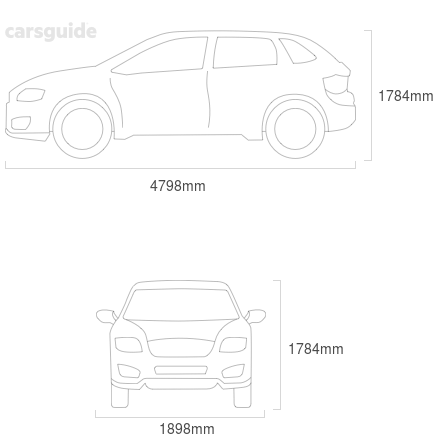
| Volvo XC90 Model | Body Type | Height x Width x Length | Ground Clearance | |
|---|---|---|---|---|
| 2.5T | SUV | 1784x1898x4798 mm | 218 mm | |
| T6 | SUV | 1784x1898x4798 mm | 218 mm | |
Volvo XC90 2003 Towing capacity
The Volvo XC90 has maximum towing capacity of 2250kg. Some models also offer heavy-duty or towing option packs which can increase towing capacity, as well as options which can hamper towing capacity. Towing capacities can vary wildly on a large number of factors. These include engine, transmission, model, and options chosen. Always check with the manufacturer or in your vehicles handbook before attempting to tow anything.
| Volvo XC90 Model | Body Type | Specs | Braked Capacity | |
|---|---|---|---|---|
| 2.5T | SUV | 2.5L,PULP,5 SP AUTO | 2250kg | |
| T6 | SUV | 2.9L,PULP,4 SP AUTO | 2250kg | |
Volvo XC90 2003 Wheel size
Wheel size for the 2003 Volvo XC90 will vary depending on model chosen, although keep in mind that many manufacturers offer alternate wheel sizes as options on many models.The wheel size available will alter the range of tyres available to be fitted. Standard wheel sizes on the Volvo XC90 vary from 17x7 inches to 18x8 inches.
| Volvo XC90 Model | Body Type | Front Tyre Size | Front Rim | Rear Tyre Size | Rear Rim | |
|---|---|---|---|---|---|---|
| 2.5T | SUV | 235x65 R17 | 17x7 inches | 235x65 R17 | 17x7 inches | |
| T6 | SUV | 235x60 R18 | 18x8 inches | 235x60 R18 | 18x8 inches | |
Volvo XC90 2003 Fuel consumption
Fuel consumption for the 2003 Volvo XC90 is dependent on the type of engine, transmission, or model chosen. The Volvo XC90 currently offers fuel consumption from 12.7 to 14.1L/100km. The Volvo XC90 is available with the following fuel type: PULP.
| Volvo XC90 Model | Body Type | Specs | Fuel Consumption | |
|---|---|---|---|---|
| 2.5T | SUV | 2.5L,PULP,5 SP AUTO | 12.7L/100km | |
| T6 | SUV | 2.9L,PULP,4 SP AUTO | 14.1L/100km | |
| T6 | SUV | 2.9L,PULP,4 SP AUTO | 14.1L/100km | |


